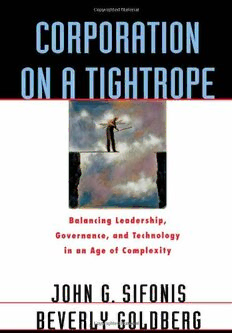
Corporation on a Tightrope: Balancing Leadership, Governance, and Technology in an Age of Complexity PDF
330 Pages·1996·20.069 MB·English
Most books are stored in the elastic cloud where traffic is expensive. For this reason, we have a limit on daily download.
Preview Corporation on a Tightrope: Balancing Leadership, Governance, and Technology in an Age of Complexity
Description:
Business is no longer business as usual. The global market is in constant flux, as some nations come together, other fall apart, trading blocs emerge, and formerly closed doors reopen. At home, leadership roles and organizational structure have seen a sea change, with the vertically integrated, tightly knit organization seemingly headed for oblivion. And the changes keep happening faster and faster. For a firm to succeed in this highly complex environment, executives need a better understanding of the deep philosophic and extensive physical adaptations needed to reshape and prepare their company for an uncertain future. To provide this deeper understanding, John G. Sifonis, a business consultant, and Beverly Goldberg, a think tank executive, who together have decades of hands-on experience, visited dozens of companies, conducted numerous interviews, and then traveled to the Sante Fe Institute, to discuss their conclusions about practical applications of complexity theory to business. The result of their study is Corporation on a Tightrope, a brilliant blend of complexity theory and hard-earned business sense, that will help executives lead their organizations into the highly uncertain future. Sifonis and Goldberg show that the flexible organization of the future will be a complex adaptive system that responds to the effects of market-driven changes on its three critical components--governance, technology, and leadership. It will be an organization capable of self-renewal, constantly reshaping itself to seize opportunities as they emerge and quickly shrink when the market changes yet again. To help executives create this flexible firm, the authors provide seven practical tools, principles that when carefully put in place create a solid foundation for the future--an organization must set unwavering ethical standards; establish a social contract; maintain a lean organization based on core competencies; develop leadership skills at every level; be open to learning, encourage experimentation, and be innovative; avoid restructuring when it should be regoverning; and ensure connectivity. The authors illustrate each of these principles with fascinating examples taken from actual corporations, such as the ethical dilemma faced by Levi's, whose move overseas brought up the problem of lost American jobs and foreign child labor; the innovative arrangement between insurance company Allmerica Financial and DST Systems, a developer of automated business solutions; and the leadership of executives such as Herb Kelleher of Southwest Airlines, who projects enthusiasm and friendliness to the media, and has his workforce reflect the same image. Readers will find other instructive anecdotes on companies such as Boeing, Texas Instruments, Shell, and Intel. Spiced with pithy quotations from prominent executives and business experts such as Peter Drucker, Edward Filene, Charles Handy, and Sam Walton, plus top people at Johnson & Johnson, Unilever, and other major corporations, this is a sweeping, visionary book that will transform the way business leaders take their companies into the future.
See more
The list of books you might like
Most books are stored in the elastic cloud where traffic is expensive. For this reason, we have a limit on daily download.
